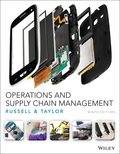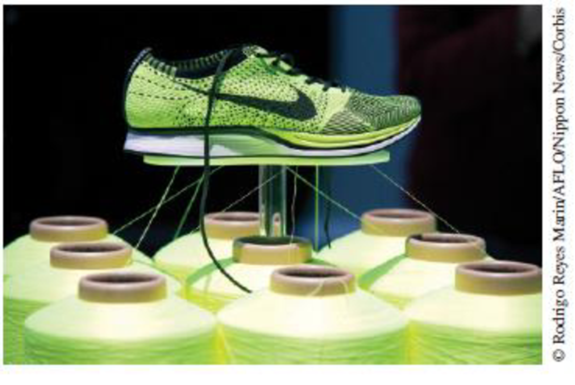
Consider Nike’s Flyknit Design
Nike has been aggressively pursuing sustainable design and production for more than a decade. Its Considered Design ethos asks designers to consider the environmental impact of a proposed product at the early stages of development; specifically, to use less toxins, less waste, more environmentally friendly materials, and more life cycle assessments (which promote recycling). To aid in that pursuit, Nike provides a list of environmentally preferred materials (EPM) and sustainable materials, as well as a restricted substances list (RSL) and restricted packaging list, to its suppliers and designers. A Considered Index is then calculated to evaluate the proposed design. Products or designs are scored on the use of solvents, waste, materials, treatments (such as fading or distressing), and innovation. Only those products that score significantly higher than the Nike average are designated as “Considered.”
The company has also developed a Sourcing & Manufacturing Sustainability Index (SMSI) that assesses contract factory performance on sustainability measures such as lean production, environmental performance (water, energy, carbon, waste), health and safety, and labor management factors. The company’s recycling program, called Reuse-A-Shoe, has recycled more than 21 million pairs of athletic shoes to create public basketball courts, athletic tracks, and playground surfaces around the world. Sustainability is now one of Nike’s core values, as noted in its recent annual report.
How appropriate, then, that one of Nike’s biggest commercial successes is also an environmental success—a 5.6 ounce running shoe called the Flyknit, which is shown in the photo. The Flyknit design changes the look, feel, performance, and manufacture of Nike’s biggest sales category, running shoes. The upper portion of these shoes are “knitted” on a custom-made 15-foot-long machine that weaves together colored polyester yarn and adds tiny synthetic cables into the weave around the midfoot for support. The cables loosen and contract with the runner’s foot, for form-fitting comfort and performance. For more stretch in the toe, Lycra-infused thread can be used; for added strength in the heel, multiple layers of yarn of varying thickness can be added. The warp and weft of the weaving process opens up interesting color combinations for the shoes as well. In the future, a shoe might be knitted to fit the particular needs of a customer’s feet (even if that means a different knit pattern for the left foot than the right).
The Flyknit has 35 fewer pieces to assemble than a traditional shoe and produces very little waste. Since there is no cutting, sewing, stitching, or gluing, the labor requirements and cost of manufacture are considerably less, too.

Nike has made great strides in apparel manufacturing, as well, with its ColorDry dyeing process. The new technology uses CO2 instead of water to dye material, eliminating wastewater pollution and avoiding depletion of a resource that is becoming increasingly scarce. Since it takes 30 liters of water to dye just one T-shirt and 5.8 trillion liters of water to dye apparel each year across the industry, using zero water makes a huge difference. The new process is 40% faster, too; it uses a quarter of the space and reduces energy consumption by 63%. Further, the color is more saturated, intense, and consistent.
Nike’s environmental actions promise to be a game-changer both for the company and the industry, and the resulting increase in profit is not bad either.
The ColorDry technology will have a huge impact on sustainability for the textile industry. Find examples of environmental “pain points” in other industries and what is being done about them.
Want to see the full answer?
Check out a sample textbook solution
Chapter 4 Solutions
Operations and Supply Chain Management 9th edition
Additional Business Textbook Solutions
Corporate Finance (4th Edition) (Pearson Series in Finance) - Standalone book
Foundations Of Finance
Financial Accounting, Student Value Edition (5th Edition)
Intermediate Accounting (2nd Edition)
Principles of Operations Management: Sustainability and Supply Chain Management (10th Edition)
Gitman: Principl Manageri Finance_15 (15th Edition) (What's New in Finance)
- Cariveh Co sells automotive supplies from 25 different locations in one country. Each branch has up to 30 staff working there, although most of the accounting systems are designed and implemented from the company's head office. All accounting systems, apart from petty cash, are computerised, with the internal audit department frequently advising and implementing controls within those systems. Cariveh has an internal audit department of six staff, all of whom have been employed at Cariveh for a minimum of five years and some for as long as 15 years. In the past, the chief internal auditor appoints staff within the internal audit department, although the chief executive officer (CEO) is responsible for appointing the chief internal auditor. The chief internal auditor reports directly to the finance director. The finance director also assists the chief internal auditor in deciding on the scope of work of the internal audit department. You are an audit manager in the internal audit…arrow_forwardPlease show all steps and answers, thank you!arrow_forwardI am not sure if this is correct, because 8 cannot go directly to 10.arrow_forward
- A practical application in real life to the Critical Path Method is the construction of a bridge with references, give a detailed essay on the stages involved in constructing a bridgearrow_forwardPlease assist in writing a complete reasearch project of the following title: Title of research: Study on the impact of Technology in the Work Place.arrow_forwardIntuition is both an emotional experience and a nonconscious analytic process. One problem, however, is that not all emotions signaling that there is a problem or opportunity represent intuition. Please in your Personal opinion how we would know if our “gut feelings” are intuition or not, and if not intuition, suggest what might be causing them.arrow_forward
- A coworker suggests that the company where you both work would be much more effective if there were no organizational politics. Please in your personal and detailed opinion, What would you say to this person in reply?arrow_forwardWhat is a bottleneck? Would you try to reduce a bottleneck? Why or why not? Please provide a referencearrow_forwardYour firm has been the auditor of Caribild Products, a listed company, for a number of years. The engagement partner has asked you to describe the matters you would consider when planning the audit for the year ended 31January 2022. During recent visit to the company you obtained the following information: (a) The management accounts for the 10 months to 30 November 2021 show a revenue of $260 million and profit before tax of $8 million. Assume sales and profits accrue evenly throughout the year. In the year ended 31 January 2021 Caribild Products had sales of $220 million and profit before tax of $16 million. (b) The company installed a new computerised inventory control system which has operated from 1 June 2021. As the inventory control system records inventory movements and current inventory quantities, the company is proposing: (i) To use the inventory quantities on the computer to value the inventory at the year-end (ii) Not to carry out an inventory count at the year-end (c)…arrow_forward
- Develop and implement a complex and scientific project for an organisation of your choice. please include report include the following: Introduction Background research to the project The 5 basic phases in the project management process Project Initiation Project Planning Project Execution Project Monitoring and Controlling Project Closing Conclusionarrow_forwardNot use ai pleasearrow_forwardSam's Pet Hotel operates 51 weeks per year, 6 days per week, and uses a continuous review inventory system. It purchases kitty litter for $11.00 per bag. The following information is available about these bags: > Demand 95 bags/week > Order cost $52.00/order > Annual holding cost = 25 percent of cost > Desired cycle-service level = 80 percent >Lead time 4 weeks (24 working days) > Standard deviation of weekly demand = 15 bags > Current on-hand inventory is 320 bags, with no open orders or backorders. a. Suppose that the weekly demand forecast of 95 bags is incorrect and actual demand averages only 75 bags per week. How much higher will total costs be, owing to the distorted EOQ caused by this forecast error? The costs will be $ higher owing to the error in EOQ. (Enter your response rounded to two decimal places.)arrow_forward
- MarketingMarketingISBN:9780357033791Author:Pride, William MPublisher:South Western Educational Publishing
 Purchasing and Supply Chain ManagementOperations ManagementISBN:9781285869681Author:Robert M. Monczka, Robert B. Handfield, Larry C. Giunipero, James L. PattersonPublisher:Cengage Learning
Purchasing and Supply Chain ManagementOperations ManagementISBN:9781285869681Author:Robert M. Monczka, Robert B. Handfield, Larry C. Giunipero, James L. PattersonPublisher:Cengage Learning Contemporary MarketingMarketingISBN:9780357033777Author:Louis E. Boone, David L. KurtzPublisher:Cengage Learning
Contemporary MarketingMarketingISBN:9780357033777Author:Louis E. Boone, David L. KurtzPublisher:Cengage Learning




